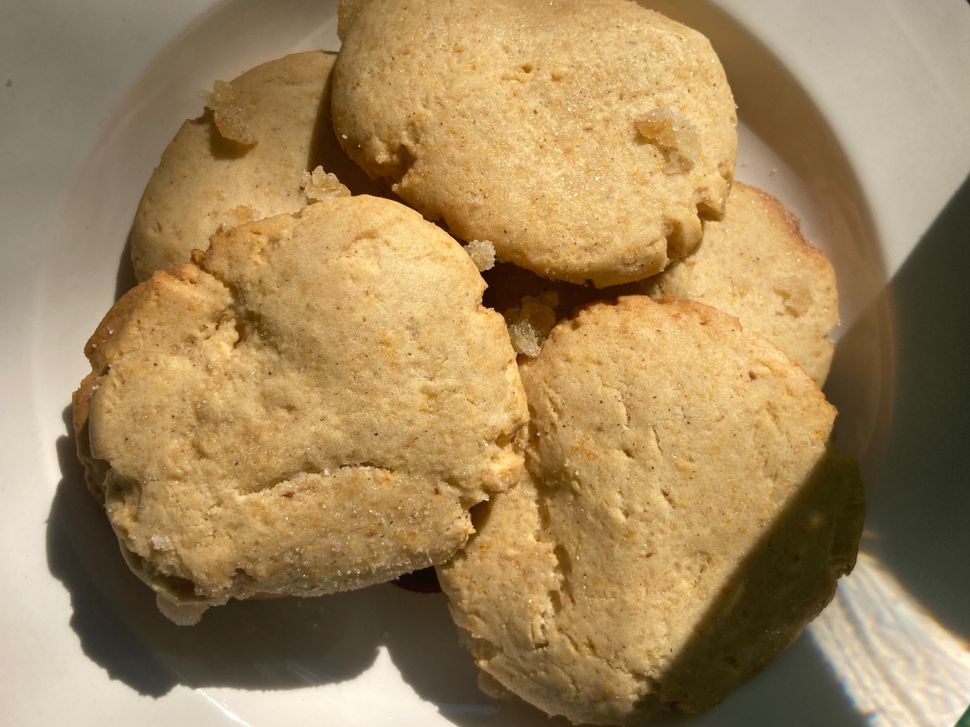This story was originally published in the Forward. Click here to get the Forward’s free email newsletters delivered to your inbox.
I’m not ashamed to admit that outside our kosher home, I don’t just eat kosher food. But admitting I don’t really like popular Jewish foods— that’s kind of embarrassing.
Here’s my short list of the foods of my People that I’d be fine living without: pickled herring, chopped liver, matzo brei, sweet kugel and honey cake. I appreciate them, I make them for others, I am open to trying yours, which I’m sure is the best. Maybe as I, God willing, turn into an Old Jew, I’ll change. I’ll learn to love mah jong and Cel-Rey and have strong opinions about whitefish salad besides, Meh. In the meantime, I just feel slightly…guilty.
In my mind, not joining all the excited online discussions about the best kugel recipes makes me a lesser Jew. My Jewish identity is more wrapped up in food than in the religious laws around it. As the great-grandson of Ashkenazic deli owners (New York Deli, 42 Clark Street, Chicago, “Try It Once”) those particular foods are my birthright. The voice that tells me I should like matzo brei is louder than the voice that tells me I shouldn’t eat cioppino.
Meanwhile, the only Jewish foods I love without exception are, oddly, Sephardic. I wouldn’t go out of my way to make Moroccan calf brains again, but you know what— beats kugel. My love for almost all foods Sephardic makes me wonder how I became such a picky Ashkenazic. Mysterious.
That brings me to honey cake. I’ve eaten too many dry, dense, bland honey cakes to ever be a fan. One of the first recipes I baked on my own was pain de miel from Bernard Clayton’s “The Breads of France and How to Bake Them.” I was a teenager, but old enough to realize, French or not, it was just another honey cake.
So, imagine my excitement to find that the Italians actually make something better: honey cookies. These cookies use no sugar, just a thick gob of the best honey you can find. They have alternating bites that are crisp and soft, moist and dry. I adapted this recipe from one in La Cucina Italiana by Giorgia Di Sabatino. Mine includes traditional Jewish honey cake spices, and a sprinkle of sugar and candied ginger. As long as you keep the flour and liquids in proportion, you can add some chopped dates, walnuts, raisins— anything that gives you that New Years vibe.
Years from now, I can easily see Italian Honey Cookies competing with Honey Cake as a traditional New Years food. That’s the way traditions work right? If you don’t find what you like in your faith, you can always innovate, adapt, improve. In this case, as with so many of the big questions in life, the answer is once again: Italian food.
High Holiday Italian honey cookies
Ingredients
9 oz type “00” flour or all-purpose flour
5 oz potato starch
5 oz flavorful honey
2 eggs
¼ oz baking powder
¼ t. each powdered ginger, allspice, cinnamon, cloves
1 small lemon (organic and untreated), zest
1 small orange (organic and untreated), zest pinch salt
3 oz cold butter, cut into small pieces
Sugar and candied ginger
Method: With your hands or in a food processor, cut the cold butter into the flour, potato starch and baking powder. Add honey, eggs, citrus zest, salt and spices. Work all ingredients with your hands or pulse in processor until just combined.
The dough should be smooth and fragrant. Cover it with plastic wrap and let it rest in the fridge for a couple of hours.
Preheat oven to 355 degrees.
Form small balls of dough with your hands, then press flat with your hands, or roll the dough out with a rolling pin to 1/8-inch thick and cut out shapes using cookie cutters.
Place the cookies on a baking sheet lined with parchment. Sprinkle with finely chopped candied ginger and sugar, if desired. Bake 15-20 minutes.
You can add 1/2 c. total chopped dates, walnuts, or raisins to the dough. You can also brush on a honey glaze to give them a shine.
Making these? Please post with #foodaism.
This article was originally published on the Forward.
